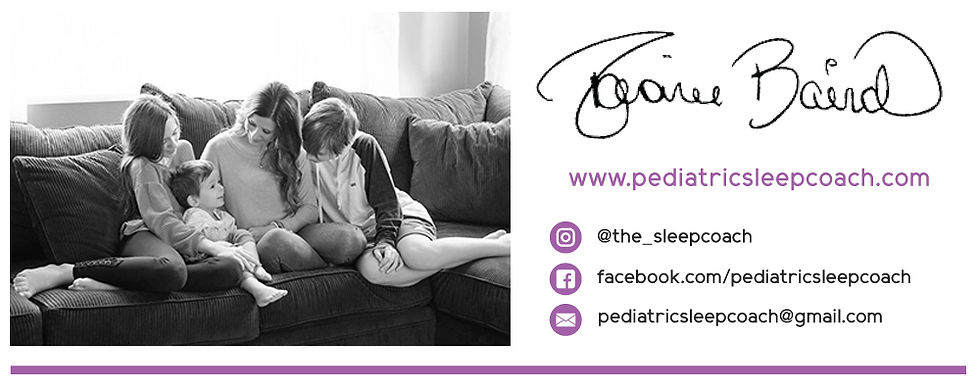Daylight Savings: How to make the transition seamless for your baby
- Desiree Baird
- Oct 9, 2020
- 4 min read
Updated: Oct 22, 2020
If you are like me, you used to LOVE getting that extra hour of sleep when daylight savings ended each year. But now that you have a baby or toddler that wakes at 6:00/6:30am your viewpoint has changed....right? YUP, I'm here for you. Don't panic!

Mark your calendar now, clocks fall back on Sunday, November 1, 2020. My motto, you can either do something or do nothing. You need to choose what works best for you and your family. Unless you live in Arizona or Hawaii, which both sound amazing right,, then the clocks are falling back whether you like it or not.
Here are three options to choose from:
1. Meet your little one in the middle the day of the change. This is great is you have a child / baby that already wakes between 7:30/8am. What you'll do is let your baby / toddler wake up naturally, and put him down for his nap 30 minutes earlier (per the clock). So for example, if your child "pre DLS" wakes at 7:30am, naps from 1:30 - 3pm and falls asleep for the night between 8:30/8:45pm, then on Sunday you will wait for your child to wake which will most likely be 6:30am if they used to wake at 7:30am, and then get their nap as close to 1pm as possible. Let him nap from 1pm - 2:30pm, and then he should be fast asleep by 8/8:15pm. If he wakes the next day at 6:30am then you can continue to push his nap as close to 1:30pm as possible for a few days, waking him no later than 3pm and then go back to your normal bedtime of 8:30ish. This method typically works well for toddlers 2 years or older. If you choose this method please set realistic expectations. Your little one may be fussy, tired, rubbing eyes, yawning and waking at night for a few days. His nap may even be a little shorter than usual, but it will go back to normal with time. Not fun, but hey, that's what wine is for on those hard days, so stock up! ;-)
2. Do nothing. Maybe your baby tends to wake up later (7:30/8am) and goes to bed later as well. In this case you may welcome the change of an earlier wake up and an earlier bedtime. For example, if your baby wakes naturally at 8am and goes to bed at 8/8:30pm then you may be excited to get them on the popular 7 - 7 schedule. So in this case, do nothing and just enjoy the early bedtimes, but know this will come with an earlier wake up than you are used to. You can't have your cake and eat it too! ;-)

3. Plan a week in advance and push out nap times by 10 min each day. If you want to do something you can push your little’one’s bedtime out 10 minutes every night for the whole week. This shift is great for young one's under 2 years old, or spirited toddlers who may need to take a gradual approach to the time change.
Below is an example of the shift for a child who normally goes to bed at 7:00pm. Seven days prior to the change you will want to begin pushing bedtime out by 10 minutes.
Monday, October 26: 7:10 PM Tuesday, October 27: 7:20 PM Wednesday, October 28: 7:30 PM Thursday, October 29: 7:40 PM Friday, October 30: 7:50 PM Saturday, October 31: 8:00 PM Sunday, November 1: 7:00 PM
Here’s another example for those babies that are bit more spirited and seem to get overtired quickly:
Monday, October 26: 7:15 PM Tuesday, October 27: 7:15 PM Wednesday, October 28 7:30 PM Thursday, October 29: 7:30PM Friday, October 30:7:45PM Saturday, October 31: 7:45PM Sunday, November 1: 7:00 PM
*Important: You will also want to push out nap schedule as well, so if baby takes two naps at 10am and 2pm then you will push them out depending on if you are doing 10 or 15 minute increments as stated above.
Some things you may notice the first week of the time change:
Baby/toddler may start yawning, rubbing eyes, or getting fussy an hour prior to their normal bedtime
Your baby may wake up earlier (6am or earlier) the first few days. This is why black out blinds and keeping room dark is essential. Do your best not to go in before 6:30am if normal wake up used to be 7am. Give your baby time to fall back to sleep on their own if they wake up earlier.
Most of all–hang in there. On average children will adjust within 7 – 14 days to the time change. And I have seen some children adjust in as little as a day!
The following pages include a planner so you can plan in advance and use these journal pages to figure out naps and bedtime. Good luck!!!
--daylight savings planner--
MONDAY TIME AWAKE FOR THE DAY: FIRST NAP: SECOND NAP: THIRD NAP: BEDTIME:
TUESDAY TIME AWAKE FOR THE DAY: FIRST NAP: SECOND NAP: THIRD NAP: BEDTIME:
WEDNESDAY TIME AWAKE FOR THE DAY: FIRST NAP: SECOND NAP: THIRD NAP: BEDTIME:
THURSDAY TIME AWAKE FOR THE DAY: FIRST NAP: SECOND NAP: THIRD NAP: BEDTIME:
FRIDAY TIME AWAKE FOR THE DAY: FIRST NAP: SECOND NAP: THIRD NAP: BEDTIME:
SATURDAY TIME AWAKE FOR THE DAY: FIRST NAP: SECOND NAP: THIRD NAP: BEDTIME:
SUNDAY TIME AWAKE FOR THE DAY: FIRST NAP: SECOND NAP: THIRD NAP: BEDTIME:
Questions? Drop me a line below or schedule a consult at pediatricsleepcoach.com/contact





Comments